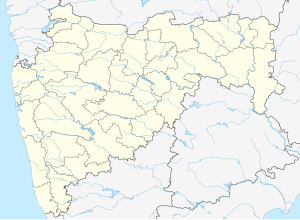| Harshagad | |
|---|---|
| हर्षगड | |
| Part of Trymbak Range | |
| Tryambakeshwar tehsil Nashik district, Maharashtra | |
 Harihar fort from Kotamwadi Harihar fort from Kotamwadi | |
 | |
| Coordinates | 19°54′17.9″N 73°28′19.2″E / 19.904972°N 73.472000°E / 19.904972; 73.472000 |
| Type | Hill fort |
| Height | 3676 Ft. |
| Site information | |
| Open to the public | Yes |
| Condition | Ruins |
| Site history | |
| Materials | Stone, bricks, alkali |
Harihar fort / Harshagad is a fort located 40 km from Nashik City, 48 km from Igatpuri, 40 km from Ghoti in Nashik district, of Maharashtra, India. It is an important fort in Nashik district, and was constructed to look upon the trade route through Gonda Ghat. It receives many visitors because of its peculiar rock-cut steps.
History
Harihar fort was built during the Seuna (Yadava) dynasty period. It was surrendered to Khan Zamam in 1636 along with Trymbak and other Pune forts. The fort was captured by Captain Briggs in 1818 along with 17 other forts.
Access
There are two base villages of the fort, Harshewadi and Nirgudpada. The Harshewadi is 13 km from Trymbakeshwar. The other base village of the fort is Nirgudpada/Kotamvadi which is 40 km from Ghoti which itself is 48 km from Nashik and 121 km from Mumbai. One can travel from Ghoti to Trimbakeshwar by bus or by private vehicle. One should take care when returning from the fort; the last bus from Trimbakeshwar is 5:30pm to Ghoti and trains are available from Nashik to Mumbai until late night. The climb from Harshewadi is easier than from the Nirgudpada. A wide, safe trekking path starts from the hil lock north of the Nirgudpada. It passes through scrub forest until it reaches an open ridge which is connected to the fort. It takes about an hour to reach the scarp of the hill on which the fort is situated. The ascent covers 60m of rock-cut steps like a stone ladder placed at 60 degrees along the scarp. The steps are worn out in many places but there are holes on either side of the steps conveniently placed for holding onto. After reaching the main entrance, the path takes a left traverse and again helical rock cut steps are to be climbed, which are more steep than the earlier ones. The steps finally end with a narrow entrance. At many places the steps are so narrow that only a single person can climb at a time. Accommodation is possible on the Harihar Fort, as well as in the local villages.
Features
There are no good structures left on the fort except for a storage house with a small entrance. There is a series of 8 rock-cut water cisterns in the centre of the fort. It takes about an hour to visit all places on the fort. The fort gives a good view of Basgad, Brahmagiri , Kapdya, Brahma hill & Feni. Along with the famous vertical stairs there are another set of stairs leading to a secret entrance




See also
References
- "Nasik District Gazetteers". Cultural.maharashtra.gov.in. 31 March 1965. Retrieved 11 August 2022.
- "Harihar Fort". Fort Trek. Archived from the original on 13 June 2021. Retrieved 17 November 2020.
- "Harihar Fort". Fort Trek. Archived from the original on 13 June 2021. Retrieved 14 November 2020.
- "Harihar, Sahyadri,Shivaji,Trekking,Marathi,Maharastra". Archived from the original on 26 February 2019. Retrieved 28 December 2016.